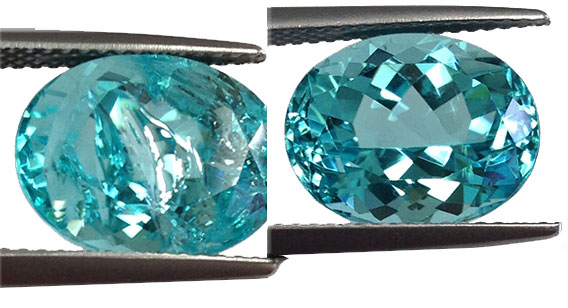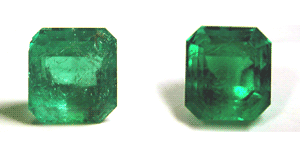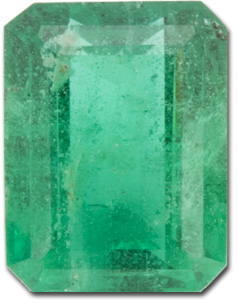Clarity Enhancements v. Inherent Vice
Clarity enhancements are multiplying – Is disclosure keeping up?
Gem enhancements have been around for a long time, but the better they get, the more likely treated stones will slip by as naturals. That's the problem.
Enhancement is a slippery word. Clarity enhancement sounds like a good thing, and in some ways it is—but in other ways it's not.
Clarity enhancement: the good
Appearance
Transparent gems appear at their best when they are clear of inclusions of non-gem material, clear of fractures or air pockets that distort the passage of light. For stones that have such inclusions, various means are used to make them less apparent.
Emerald, for example, is a gem material that is by nature highly included. Oiling is a routine practice that minimizes the visibility of surface fissures without affecting the gem's value or durability.
Fracture-filling is a much more drastic treatment, or enhancement. It masks fractures by filling them with a material that has a refractive index similar to that of the gem material. This allows light to pass through with minimal distortion. The treatment allows even highly defective emeralds, unattractive stones that would otherwise be discarded, to look good.
The transformation in a stone's appearance can be dramatic. Only a trained gemologist observing the stone under high magnification would see the flaws.
Price
Fracture-filling allows the consumer to get a good-looking gem at a lower price. Because fracture-filling treatment is used on low-quality (and lower value) stones, an "enhanced" gem should be considerably lower in price than an untreated gem of similar appearance. (Note that we say should. See further discussion under Disclosure, below.)
Clarity enhancement: the not-so-good
Filling breakdown
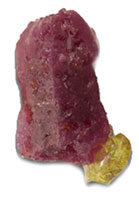 Yellow fill material
Yellow fill material still attached to a piece
of ruby rough
Photo by Fred Kahn
and Sun Joo Chung of AGL
Literally hundreds of proprietary formulas have been used to fill fractures and fissures. Most clarity treatments are unstable: the filling material may become cloudy, dry up, or leak out. The jewelry owner may file a claim, believing the stone has been damaged, when actually the fill material has just deteriorated, leaving the stone's fractures exposed and visible. (This is not damage for which the insurer is liable). The clarity treatment may have to be repeated every few years to keep the gem looking good.
CEL (Clarity Enhancement Laboratory) developed a process for treating fractures in emerald and, more recently, in tourmaline as well. The company claims its enhancements for emerald and tourmaline – called Ex-Cel – are completely stable; they do not discolor, dry out, appear cloudy, or leak out.
Gem durability
Clarity enhancement DOES NOT improve the stone's durability. It just hides the stone's defects.
Although fractures in a treated stone are not visible (to the unaided eye), they are still there. A fracture-filled gem is not solid gem material. A gem with fractures, even if they are filled, is more vulnerable to damage from impact or even from pressure used in setting the stone.
The extent of the fractures affects the stone's vulnerability. A highly fractured stone, like the emerald at right, would be more easily damaged that a stone with a few minor fissures.
The photo below shows a watermelon tourmaline before and after fracture filling treatment. The fact that the main fracture seems to run right through the center of the stone makes this treated stone quite vulnerable to damage.
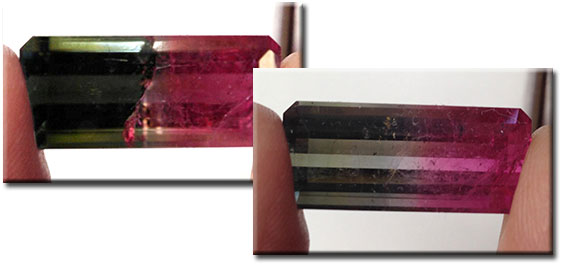 Watermelon tourmaline, before & after enhancement
Watermelon tourmaline, before & after enhancementPhoto courtesy of Arthur Groom of Clarity Enhancement Laboratory (CEL)
Importance of Disclosure!
Disclosure of all treatments must be made all down the selling chain—and this doesn't always happen. Not all jewelers recognize treatments or examine the merchandise they sell. Many jewelers and even gem suppliers do not realize that traditional enhancements are unstable. And disclosure documents can get "lost."
Without disclosure, whether it is intentional or out of ignorance, the consumer may pay more than the jewelry is worth, as a treated stone is worth less than an untreated stone of similar appearance. The jewelry's premiums may be higher than necessary, and an insurer's settlement could be excessive. Damage that resulted from a pre-existing fracture would be due to inherent vice, an excluded peril.
For the consumer, the word "enhanced" is not sufficient disclosure. The seller should explain what clarity enhancement is, why it is done, whether the treated stone requires special care, and why an enhanced gem is priced lower than an "unenhanced" gem of similar appearance.
In fact, true disclosure would require "before & after" pictures of the treated stone—which would most likely kill any chance of a retail sale. If the jewelry industry really supported full disclosure, these treatments would be described as "fracture-filling" rather than sugar-coated as "clarity enhancement."
All enhancements should be noted on the sales document.
An appraisal should specifically state any enhancements done to the gem, or it should explicitly state that the gem is untreated. A conscientious appraiser will also note how serious the enhancement is; a stone with a couple of small fractures filled is not as vulnerable as one that is riddled with fractures. (See Composite Rubies for a discussion of "gems" that are literally held together by non-gem material, and the lawsuit resulting from nondisclosure.)
CEL (Clarity Enhancement Laboratory) states that its Ex-Cel fillings for fissures in emerald and tourmaline are stable. A gemologist can tell whether a gem has been fracture-filled but usually cannot determine the material or process used.
If an emerald has been clarity enhanced, a GIA report will give some indication of the degree of treatment. GIA uses the "politically correct" grades F1, F2 and F3. The GIA site says:
This is a judgment of the degree of clarity enhancement: minor (F1), moderate (F2), and significant (F3). "Minor" enhancement indicates the treatment has had only a slight effect on the face-up appearance, whereas "significant" indicates an obvious effect on the appearance.
FOR AGENTS & UNDERWRITERS
Be sure the appraisal states any treatments (enhancements) done to the gem, or states that the stone is untreated, as this can have a huge effect on value.
Your client may present an appraisal from the seller. For high-value gems, recommend an appraisal from an appraiser who is a GG or FGA, is independent of the seller, and preferably is also a Certified Insurance Appraiser™.
"Paraiba" tourmaline commands a high price, so some sellers are likely to extend the reach of the word Paraiba as far as possible. Before insuring this gem, you may want to review our issue on Paraiba tourmaline. The increasingly widespread use of fracture filling in tourmaline is an extra reason to be cautious.
Ultimately it is quality that gives tourmaline its value. Be sure the appraiser is a jeweler who regularly deals in these stones, is aware of the current controversy over nomenclature, can recognize gem enhancements, and is qualified to judge the gem's value.
High-value colored gems should be accompanied by a report from a reliable lab (such as AGL or Gübelin). The report will describe any treatments. It's best to have a report that also includes the gem's country of origin.
FOR ADJUSTERS
Comb the appraisal and other documents for references to treatments or enhancements. A color- or clarity-enhanced stone should be replaced by a similarly treated stone.
For damaged stones, remember that the breakdown of a fracture-fill material is not damage for which the insurer is liable.
When settling a claim on Paraiba tourmaline, be sure to consult a jeweler who regularly deals with tourmaline and can determine quality and valuation in the current market.
©2000-2025, JCRS Inland Marine Solutions, Inc. All Rights Reserved. www.jcrs.com

